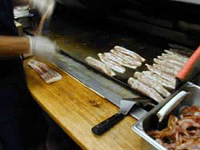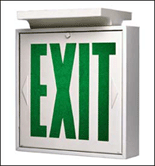Employers have the primary responsibility for protecting the safety and health of their workers. Employees are responsible for following the safe work practices of their employers.
 Grill
Grill
 Grill
Grill
 Chemical extinguishing system
Chemical extinguishing system
 Class K fire extinguisher
Class K fire extinguisher

Exit sign
- Provide procedures for regular maintenance of safeguards installed on heat-producing equipment to prevent the accidental ignition of combustible materials;
[1910.39(c)(3)].
- Inform employees upon initial assignment to a job of the fire hazards to which they are exposed. An employer must also review with each employee those parts of the fire prevention plan necessary for self-protection [1910.39(d)].
- Follow the requirements of 1910.161, Dry Chemical Fire Extinguishers and 1910.160, Fixed Extinguishing Systems for fixed
dry chemical extinguishing systems used to fight grease fires.
- Ensure that electrical equipment is free from recognized hazards that are likely to cause death or serious physical harm to employees [1910.303(b)(1)].
- Wiring methods, components, and equipment for general use [1910.305].
- Provide
exit routes, emergency action plans, and fire prevention plans.
- Ensure that if fire extinguishers are required or provided in your workplace, and if anyone will be evacuating during a fire or other emergency, that you have an emergency action plan (EAP) and fire prevention plan [1910.157].
- Educate employees about the correct use of fire extinguishers if they are expected to fight fires as part of an emergency action plan [1910.157(g)(3)].
- Training must include information about approved types of extinguishers [1910.157(c)(2)]. Class K fire extinguishers are approved in kitchens.
- Provide for any area under construction or under maintenance including:
- Exit routes must be maintained during construction, repairs, or alterations [1910.37(d)].
- Employees must not occupy a workplace unless the exit routes required are available and existing fire protections are maintained, or until alternate fire protection is furnished that provides an equivalent level of safety [1910.37(d)(2)].
- Employees must not be exposed to hazards of flammable or explosive substances or equipment used during construction,
repairs, or alterations, that are beyond the normal permissible conditions in the workplace, or that would impede exiting the workplace [1910.37(d)(3)].
|